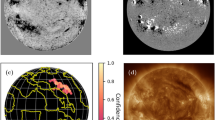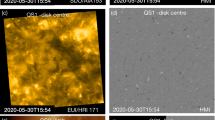Abstract
The HERSCHEL (helium resonant scattering in the corona and heliosphere) experiment is a rocket mission that was successfully launched last September from White Sands Missile Range, New Mexico, USA. HERSCHEL was conceived to investigate the solar corona in the extreme UV (EUV) and in the visible broadband polarized brightness and provided, for the first time, a global map of helium in the solar environment. The HERSCHEL payload consisted of a telescope, HERSCHEL EUV Imaging Telescope (HEIT), and two coronagraphs, HECOR (helium coronagraph) and SCORE (sounding coronagraph experiment). The SCORE instrument was designed and developed mainly by Italian research institutes and it is an imaging coronagraph to observe the solar corona from 1.4 to 4 solar radii. SCORE has two detectors for the EUV lines at 121.6 nm (HI) and 30.4 nm (HeII) and the visible broadband polarized brightness. The SCORE UV detector is an intensified CCD with a microchannel plate coupled to a CCD through a fiber-optic bundle. The SCORE visible light detector is a frame-transfer CCD coupled to a polarimeter based on a liquid crystal variable retarder plate. The SCORE coronagraph is described together with the performances of the cameras for imaging the solar corona.

During an eclipse the Sun shows a bright region surrounding its disk: the solar corona. The corona is composed by a continuous flux of charged particles that leave the Sun surface and spread all over the space. This flux is known as the solar wind and our planet is wrapped by this breeze of particles. The temperature of the solar corona is surprisingly high, and the most part of emitted radiation falls into ultraviolet band. Studying the dynamic processes driving the solar wind is not only relevant to understand how our star works, but also for the safety of our own lives



Similar content being viewed by others
Explore related subjects
Discover the latest articles and news from researchers in related subjects, suggested using machine learning.References
McComas DJ et al (1998) Geophys Res Lett 25(1):1–4
von Steiger R et al (2000) J Geophys Res 105:27217
Bürgi A (1992) J Geophys Res 97:3137–3150
Aellig MR, Lazarus AJ, Steinberg JT (2001) Geophys Res Lett 28(14):2767–2770
Delaboudinière JP et al (1995) Sol Phys 162:291–312
Auchère F et al (2007) Proc SPIE 6689:66890A
Landini F et al (2006) Appl Opt 45(26):6657–6667
Gherardi A, Romoli M, Pace E, Pancrazzi M, Rossi G, Paganini D, Focardi M (2009) Astrophys Space Sci 320:239–241
Romoli M et al (2002) In: Proceedings of the tenth international solar wind conference, pp 846–849
European Cooperation for Space Standardization (2003) ECSS-E-50-12A
Janesick JR (2001) Scientific charge-coupled devices. SPIE publication PM83. SPIE, Bellingham, pp 95–110
Acknowledgements
We are very grateful to Ziyu Wu and Augusto Marcelli for having invited one of us (M.P.) to the ITSR09 conference, giving great opportunity to discuss this work. We express our gratitude to the NRL scientific and technical team for the invaluable support during calibration and testing of SCORE, for the fruitful discussions on the topic, and for having offered us their experience. This work is supported by the Italian Space Agency contract ASI/I/015/07.
Author information
Authors and Affiliations
Corresponding author
Rights and permissions
About this article
Cite this article
Pancrazzi, M., Focardi, M., Landini, F. et al. HERSCHEL/SCORE, imaging the solar corona in visible and EUV light: CCD camera characterization. Anal Bioanal Chem 397, 2033–2038 (2010). https://doi.org/10.1007/s00216-010-3697-5
Received:
Revised:
Accepted:
Published:
Issue Date:
DOI: https://doi.org/10.1007/s00216-010-3697-5




